What is cancel culture? It is the phenomenon of celebrities, companies or shows being boycotted or ostracized due to offensive comments or beliefs. This often results in the guilty party losing many of their followers and in significant financial loss. Why is this a part of a modern day society and what factors are at play? We can apply balance theory in order to help explain some of what drives cancel culture and empowers it.
Take for instance the incident where Logan Paul recorded a video and made insensitive remarks at a ‘suicide forest’ in Japan. This sparked major controversy amongst his viewers and peers and led to Logan Paul being canceled. As a result, Logan lost many of his sponsorship deals, was removed from Google’s partner program and his Youtube Red series was canceled.
To help us further understand the factors at play in this situation, let us apply the balance theory to before and after the Logan paul incident.
Before the Logan Paul ‘suicide forest’ incident there was a balanced relationship between Logan Paul, his fans and his sponsors (see Diagram 1.1). Logan Paul’s fans had a positive relationship with him, he positively supported his sponsors and therefore his fans also tended to have a positive impression of his sponsors. We have three positive connections in this triad and hence by structural balance theory, this triangle relationship is balanced.
The following Diagrams 1.1-1.4 have been adapted from Dalakas’ and Levins diagrams about NASCAR fans, their favorite drivers and that driver’s sponsors. Re-contextualized to help explain cancel culture (Vassilis Dalakas and Aron M. Levin 2005). See more about that study at the end of this blog post.
Diagram 1.1
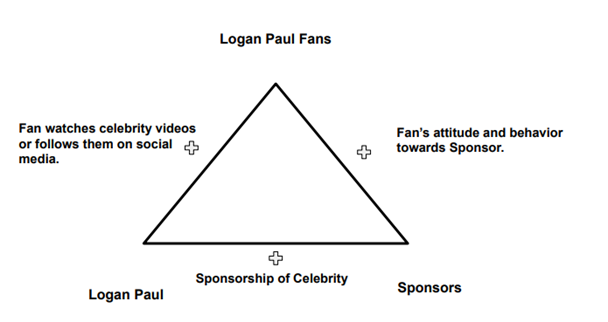
However after the incident, the balance of this triangle has been broken. Now, many of Logan Paul’s fans, viewers and even non-viewers have turned their back on him and are actively trying to get him canceled (see Diagram 1.2). This surely constitutes a negative relationship between Logan Paul and his fans. Now in the triad, there are two positive connections and one negative connection. By structural balance theory, this is an unbalanced triangle. Therefore, the parties in this triangle will seek to return to a balanced state. There are three ways the triangle can become balanced once more. The first is Logan Paul’s fans develop a negative attitude towards his sponsors and proceed to boycott them (see Diagram 1.3). The second is Logan Paul’s sponsors announcing the end of their partnership with him and thus absolving themselves of any potential backlash due to their connection with him (see Diagram 1.4). The third being that Logan Paul is able to repair his relations and image with his fans and viewers. In the first two cases we will end up with a triangle with two negative connections and one positive relationship and hence will once more be balanced. The third option restores his connection with his fans. Thus the triangle will have three positive connections and is balanced. The most common methods we see happening are the latter two options for rebalancing. The celebrity will make an emotional apology video and try to convince their fans to forgive them. In the case of minor offenses this approach can sometimes be effective. But in more serious cases, as in Logan’s, his fans and viewers did not accept his apology video. Thus the second case played out, where all of Logan’s sponsors ceased any partnership with him and distanced themselves.
Diagram 1.2
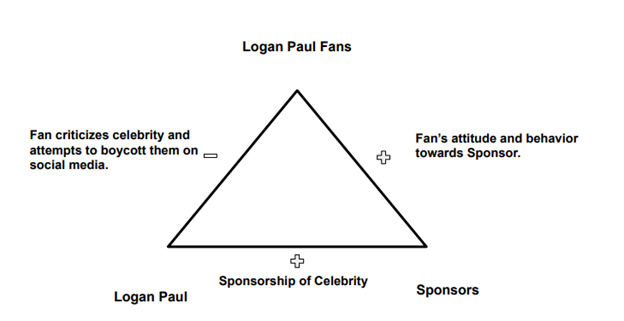 Diagram 1.3
Diagram 1.3
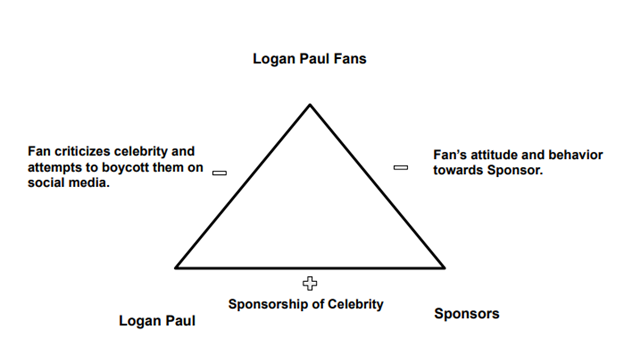
Diagram 1.4
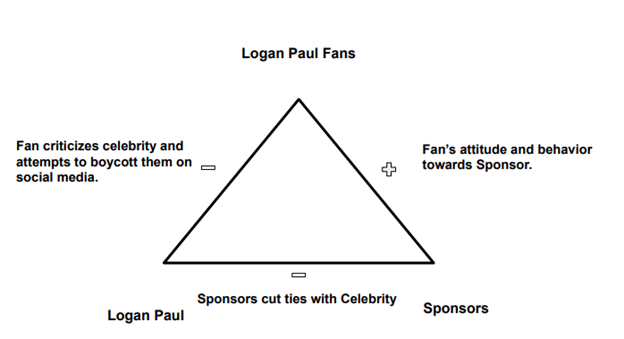
Now we have seen how balance theory helps to explain what factors are at play and how each party plays a role in cancel culture. Ultimately, it is up to the celebrity to help maintain balance between themselves, their fans and their sponsors. If done correctly, everyone is happy and gains mutual benefit from this relationship triad. The celebrity gains popularity, the fans can enjoy content from the celebrity and the sponsor can grow their brand. If done incorrectly, then the balance quickly breaks apart and can result in major negative consequences for the celebrity.
This type of dynamic is not only limited to cancel culture, it is also applicable to society at large. For example, in a study conducted by Vassilis Dalakas and Aron M. Levin from Northern Kentucky University; they hypothesized similar relationships between NASCAR fans, their favorite drivers and that drivers sponsors. They gathered empirical evidence to help corroborate their hypotheses. In my analysis of cancel culture, I extended the results from their study to help explain how cancel culture works and why it is so prevalent in our society today. If you would like to learn more about Dalakas’ and Levin’s study you can read more here https://www.acrwebsite.org/volumes/9038.
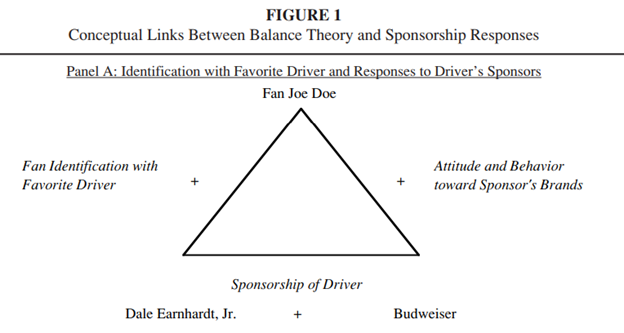 (Figure 1, Vassilis Dalakas and Aron M. Levin 2005)
(Figure 1, Vassilis Dalakas and Aron M. Levin 2005)
Sources:
Vassilis Dalakas and Aron M. Levin (2005) ,”The Balance Theory Domino: How Sponsorships May Elicit Negative Consumer Attitudes”, in NA – Advances in Consumer Research Volume 32, eds. Geeta Menon and Akshay R. Rao, Duluth, MN : Association for Consumer Research, Pages: 91-97.